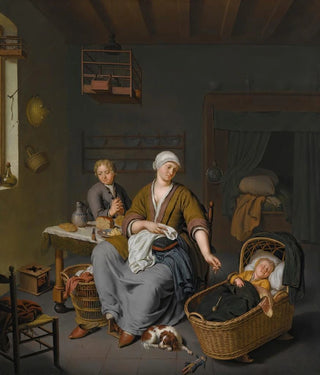Art print | A young mother caring for her two children in a domestic interior - Willem van Mieris


View from behind

Frame (optional)
Art print of a young mother caring for her two children in a domestic interior - Willem van Mieris – Captivating introduction
In the world of art, some works stand out for their ability to capture everyday moments with such finesse that they transcend time. "A young mother caring for her two children in a domestic interior" by Willem van Mieris is one of these pieces. This painting, which evokes tenderness and the simplicity of family life, invites us to delve into an intimate universe where daily gestures become a source of beauty. Through this work, the artist offers us a glimpse of domestic life in the 17th century, while highlighting the emotional bonds that unite family members. The scene depicted is both touching and universal, resonating with anyone who has known a mother's love.
Style and uniqueness of the work
Willem van Mieris, master of portrait and genre scene, stands out for his meticulous attention to detail and subtle use of light. In this piece, the composition is carefully orchestrated, with each element contributing to creating a warm and welcoming atmosphere. The textures of the clothing, the softness of the children's faces, and the light filtering through the window are all elements that demonstrate the artist's technical mastery. Van Mieris excels in depicting emotions, and here, the tenderness of the mother for her children is palpable. The choice of colors, soft and harmonious, reinforces this impression of serenity. This painting does not merely depict a domestic scene; it captures the very essence of maternal love and devotion, elevating the everyday to a level of visual poetry.
The artist and his influence
Willem van Mieris, active in the 17th century, is often regarded as one of the major representatives of the Dutch school of painting. His work, although less well-known than that of his contemporaries such as Vermeer or Rembrandt, possesses a delicacy and sensitivity that deserve recognition. The artist draws inspiration from daily life and human relationships, seeking to immortalize moments of tenderness and simplicity. His technique, characterized by

Matte finish

View from behind

Frame (optional)
Art print of a young mother caring for her two children in a domestic interior - Willem van Mieris – Captivating introduction
In the world of art, some works stand out for their ability to capture everyday moments with such finesse that they transcend time. "A young mother caring for her two children in a domestic interior" by Willem van Mieris is one of these pieces. This painting, which evokes tenderness and the simplicity of family life, invites us to delve into an intimate universe where daily gestures become a source of beauty. Through this work, the artist offers us a glimpse of domestic life in the 17th century, while highlighting the emotional bonds that unite family members. The scene depicted is both touching and universal, resonating with anyone who has known a mother's love.
Style and uniqueness of the work
Willem van Mieris, master of portrait and genre scene, stands out for his meticulous attention to detail and subtle use of light. In this piece, the composition is carefully orchestrated, with each element contributing to creating a warm and welcoming atmosphere. The textures of the clothing, the softness of the children's faces, and the light filtering through the window are all elements that demonstrate the artist's technical mastery. Van Mieris excels in depicting emotions, and here, the tenderness of the mother for her children is palpable. The choice of colors, soft and harmonious, reinforces this impression of serenity. This painting does not merely depict a domestic scene; it captures the very essence of maternal love and devotion, elevating the everyday to a level of visual poetry.
The artist and his influence
Willem van Mieris, active in the 17th century, is often regarded as one of the major representatives of the Dutch school of painting. His work, although less well-known than that of his contemporaries such as Vermeer or Rembrandt, possesses a delicacy and sensitivity that deserve recognition. The artist draws inspiration from daily life and human relationships, seeking to immortalize moments of tenderness and simplicity. His technique, characterized by






